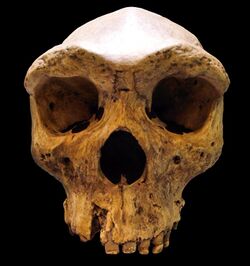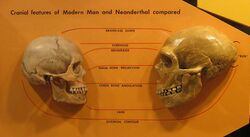Biology:Archaic humans

{{Graphical timeline
|
| help=off | link-to=Human timeline
| scale-increment=1.000 | plot-colour=#ffc966 | from=-10.000 | to=-0.000
| title=Hominin timeline
| bar1-from=-10.000 | bar1-to=-2.800 | bar1-text=Hominini | bar1-colour=#ffa500 | bar1-left=0.0 | bar1-nudge-right=-0.3 | bar1-nudge-down=-3.3
| bar2-from=-9.800 | bar2-to=-9.700 | bar2-text=Nakalipithecus | bar2-colour=#ffa500 | bar2-left=0.1 | bar2-nudge-down=0 | bar2-nudge-left=0.5
| bar3-from=-9.000 | bar3-to=-8.900 | bar3-text=Ouranopithecus | bar3-colour=#ffa500 | bar3-left=0.1 | bar3-nudge-down=0 | bar3-nudge-left=0.3
| bar4-from=-7.000 | bar4-to=-6.900 | bar4-text=Sahelanthropus | bar4-colour=#ffa500 | bar4-left=0.1 | bar4-nudge-down=0 | bar4-nudge-left=0.3
| bar5-from=-6.000 | bar5-to=-5.900 | bar5-text=Orrorin | bar5-colour=#ffa500 | bar5-left=0.1 | bar5-nudge-down=0 | bar5-nudge-left=2.0
| bar6-from=-4.400 | bar6-to=-4.300 | bar6-text=Ardipithecus | bar6-colour=#ffa500 | bar6-left=0.1 | bar6-nudge-down=0 | bar6-nudge-left=1.0
| bar7-from=-3.600 | bar7-to=-1.200 | bar7-text=Australopithecus | bar7-colour=#ffa500 | bar7-left=0.0 | bar7-nudge-down=4 | bar7-nudge-left=0 | bar7-nudge-right=0.4
| bar8-from=-2.800 | bar8-to=-1.500 | bar8-text=Homo habilis | bar8-colour=#ffb732 | bar8-left=0.1 | bar8-nudge-right=0.4 | bar8-nudge-down=0.3
| bar9-from=-1.900 | bar9-to=-0.035 | bar9-text=Homo erectus | bar9-colour=#ffc966 | bar9-left=0.2 | bar9-nudge-right=0.1 | bar9-nudge-down=1.0
| bar10-from=-1.500 | bar10-to=-1.200 | bar10-text= | bar10-colour=#ffc966 | bar10-left=0.1 | bar10-right=0.2 | bar10-nudge-right=0.0 | bar10-nudge-down=0.0
| bar11-from=-0.700 | bar11-to=-0.2 | bar11-text=H. heidelbergensis | bar11-colour=#ffeeaa | bar11-left=0.1 | bar11-nudge-right=0.5 | bar11-nudge-down=0.3
| bar12-from=-0.3 | bar12-to=-0.000 | bar12-text=Homo sapiens | bar12-colour=#ffff00 | bar12-left=0.4 | bar12-nudge-right=0.0 | bar12-nudge-down=0.0
| bar13-from=-0.035 | bar13-to=-0.000 | bar13-text= | bar13-colour=#ffeeaa | bar13-left=0.0 | bar13-right=0.1 | bar13-nudge-right=0.0 | bar13-nudge-down=0.0
| bar14-from=-0.040 | bar14-to=-0.000 | bar14-text= | bar14-colour=#ffff00 | bar14-left=0.1 | bar14-right=0.4 | bar14-nudge-right=0.0 | bar14-nudge-down=0.0
| bar15-from=-0.25 | bar15-to=-0.04 | bar15-text=Neanderthals | bar15-colour=#ffeeaa | bar15-left=0.1 | bar15-right=0.4 | bar15-nudge-left=0.2 | bar15-nudge-down=0.2
| note3-at=-10.000 | note3=Earlier apes
| note4-at=-9.000
| note4=Gorilla split
| note5-at=-7.000 | note5=Possibly bipedal
| note8-at=-5.800
| note8=Chimpanzee split
| note10-at=-4.050 | note10=Earliest bipedal
| note12-at=-3.300 | note12=Stone tools
| note14-at=-1.800
| note14=Exit from Africa
| note15-at=-1.500 | note15=[[Biology:Control of fire by early humans#Lower Paleolithic evidence
| note20-at=-0.050 | note20=Modern humans
| note21=
P
l
e
i
s
t
o
c
e
n
e
| note21-at=-0.00 | note21-nudge-left=13 | note21-remove-arrow=yes
| note22=
P
l
i
o
c
e
n
e
| note22-at=-3.50 | note22-nudge-left=13 | note22-remove-arrow=yes
| note23=
M
i
o
c
e
n
e
| note23-at=-6.75 | note23-nudge-left=13 | note23-remove-arrow=yes
| note24=
H
o
m
i
n
i
d
s
| note24-at=-4.20 | note24-nudge-left=0 | note24-nudge-right=-4.20 | note24-remove-arrow=yes
| caption=
}} A number of varieties of Homo are grouped into the broad category of archaic humans[lower-alpha 1] in the period that precedes and is contemporary to the emergence of the earliest early modern humans (Homo sapiens) around 300 ka. Among the earliest remains of H. sapiens are those from Jebel Irhoud in Morocco (about 315 ka), Florisbad in South Africa (259 ka),[1][2][3][4][5][6] and Omo-Kibish I (Omo I) in southern Ethiopia (c. 195 or 233 ka).[2][7] The term typically includes H. antecessor, H. bodoensis, Denisovans (H. denisova), H. heidelbergensis (600–200 ka), Neanderthals (H. neanderthalensis; 430 ± 25 ka),[8] and H. rhodesiensis (300–125 ka).
Archaic humans had a brain size averaging 1,200 to 1,400 cubic centimeters, which overlaps with the range of modern humans. Archaics are distinguished from anatomically modern humans by having a thick skull, prominent supraorbital ridges (brow ridges) and the lack of a prominent chin.[9][10]
Anatomically modern humans appeared around 300,000 years ago in Africa,[4][5][6] and 70,000 years ago gradually supplanted the "archaic" human varieties. Non-modern varieties of Homo are certain to have survived until after 30,000 years ago, and perhaps until as recently as 12,000 years ago.[lower-alpha 2] According to recent genetic studies, modern humans may have bred with two or more groups of archaic humans, including Neanderthals and Denisovans.[11] Other studies have cast doubt on admixture being the source of the shared genetic markers between archaic and modern humans, pointing to an ancestral origin of the traits which originated 500,000–800,000 years ago.[12][13][14] In August 2023, scientists reported the discovery of an unknown ancient human hominin that may have lived 300,000 years ago in China.[15][16]
Terminology and definition
The category archaic human lacks a single, agreed definition.[9] According to one definition, Homo sapiens is a single species comprising several subspecies that include the archaics and modern humans. Under this definition, modern humans are referred to as Homo sapiens sapiens and archaics are also designated with the prefix "Homo sapiens". For example, the Neanderthals are Homo sapiens neanderthalensis, and Homo heidelbergensis is Homo sapiens heidelbergensis. Other taxonomists prefer not to consider archaics and modern humans as a single species but as several different species. In this case the standard taxonomy is used, i.e. Homo rhodesiensis, or Homo neanderthalensis.[9]
The evolutionary dividing lines that separate modern humans from archaic humans and archaic humans from Homo erectus are unclear. The earliest known fossils of anatomically modern humans such as the Omo remains from 195,000 years ago, Homo sapiens idaltu from 160,000 years ago, and Qafzeh remains from 90,000 years ago are recognizably modern humans. These early modern humans possess a number of archaic traits, such as moderate, but not prominent, brow ridges.
Brain size expansion
The emergence of archaic humans is sometimes used as an example of punctuated equilibrium.[17] This occurs when a species undergoes significant biological evolution within a relatively short period. Subsequently, the species undergoes very little change for long periods until the next punctuation. The brain size of archaic humans expanded significantly from 900 cm3 (55 cu in) in erectus to 1,300 cm3 (79 cu in). Since the peak of human brain size during the archaics, it has begun to decline.[18]
Origin of language
Robin Dunbar has argued that archaic humans were the first to use language. Based on his analysis of the relationship between brain size and hominin group size, he concluded that because archaic humans had large brains, they must have lived in groups of over 120 individuals. Dunbar argues that it was not possible for hominins to live in such large groups without using language, otherwise there could be no group cohesion and the group would disintegrate. By comparison, chimpanzees live in smaller groups of up to 50 individuals.[19][20]
Fossils
- Altamura Man
- Atapuerca Mountains, Sima de los Huesos
- Cro-magnon Man
- Dragon Man
- Kabwe skull
- Ndutu cranium
- Saldanha man
- Steinheim skull
See also
- Dawn of Humanity (2015 PBS film)
- Early human migrations
- Evolution of human intelligence
- Human evolution
- Interbreeding between archaic and modern humans
- Middle Paleolithic
- Neanderthal extinction
- Recent African origin of modern humans
- Toba catastrophe theory
References
Footnotes
- ↑ There is no universal consensus on this terminology, and varieties of "archaic humans" are included under the binomial name of either H. sapiens or H. erectus by some authors.
- ↑ Which of these, if any, are included under the term "archaic human" is a matter of definition and varies among authors.
Citations
- ↑ Stringer, C. (2016). "The origin and evolution of Homo sapiens". Philosophical Transactions of the Royal Society of London. Series B, Biological Sciences 371 (1698): 20150237. doi:10.1098/rstb.2015.0237. PMID 27298468.
- ↑ 2.0 2.1 Hammond, Ashley S.; Royer, Danielle F.; Fleagle, John G. (Jul 2017). "The Omo-Kibish I pelvis". Journal of Human Evolution 108: 199–219. doi:10.1016/j.jhevol.2017.04.004. ISSN 1095-8606. PMID 28552208.
- ↑ White, Tim D.; Asfaw, B.; DeGusta, D.; Gilbert, H.; Richards, G. D.; Suwa, G.; Howell, F. C. (2003). "Pleistocene Homo sapiens from Middle Awash, Ethiopia". Nature 423 (6491): 742–747. doi:10.1038/nature01669. PMID 12802332. Bibcode: 2003Natur.423..742W.
- ↑ 4.0 4.1 Callaway, Ewan (7 June 2017). "Oldest Homo sapiens fossil claim rewrites our species' history". Nature. doi:10.1038/nature.2017.22114. http://www.nature.com/news/oldest-homo-sapiens-fossil-claim-rewrites-our-species-history-1.22114. Retrieved 11 June 2017.
- ↑ 5.0 5.1 Sample, Ian (7 June 2017). "Oldest Homo sapiens bones ever found shake foundations of the human story". The Guardian. https://www.theguardian.com/science/2017/jun/07/oldest-homo-sapiens-bones-ever-found-shake-foundations-of-the-human-story.
- ↑ 6.0 6.1 Hublin, Jean-Jacques; Ben-Ncer, Abdelouahed; Bailey, Shara E.; Freidline, Sarah E.; Neubauer, Simon; Skinner, Matthew M.; Bergmann, Inga; Le Cabec, Adeline et al. (2017). "New fossils from Jebel Irhoud, Morocco and the pan-African origin of Homo sapiens". Nature 546 (7657): 289–292. doi:10.1038/nature22336. PMID 28593953. Bibcode: 2017Natur.546..289H. http://kar.kent.ac.uk/62267/1/Submission_288356_1_art_file_2637492_j96j1b.pdf.
- ↑ Vidal, Celine M. et al. (Jan 2022). "Age of the oldest known Homo sapiens from eastern Africa". Nature 601 (7894): 579–583. doi:10.1038/s41586-021-04275-8. PMID 35022610. Bibcode: 2022Natur.601..579V.
- ↑ Hublin, J. J. (2009). "The origin of Neandertals". Proceedings of the National Academy of Sciences 106 (38): 16022–16027. doi:10.1073/pnas.0904119106. PMID 19805257. Bibcode: 2009PNAS..10616022H.
- ↑ 9.0 9.1 9.2 Dawkins (2005). "Archaic homo sapiens". The Ancestor's Tale. Boston: Mariner. ISBN 978-0618619160. https://books.google.com/books?id=rR9XPnaqvCMC.
- ↑ Barker, Graeme (1999). Companion Encyclopedia of Archaeology. Routledge. ISBN 978-0415213295. https://books.google.com/books?id=c4BZ7vu0WRsC&pg=RA1-PA783.
- ↑ Mitchell, Alanna (January 30, 2012). "DNA Turning Human Story Into a Tell-All". The New York Times. https://www.nytimes.com/2012/01/31/science/gains-in-dna-are-speeding-research-into-human-origins.html.
- ↑ Telegraph Reporters (14 August 2012). "Neanderthals did not interbreed with humans, scientists find" (in en). Telegraph.co.uk. https://www.telegraph.co.uk/news/science/science-news/9474109/Neanderthals-did-not-interbreed-with-humans-scientists-find.html.
- ↑ "Neanderthals 'unlikely to have interbred with human ancestors'". The Guardian. Press Association. 4 February 2013. https://www.theguardian.com/science/2013/feb/04/neanderthals-modern-humans-research.
- ↑ Lowery, Robert K.; Uribe, Gabriel; Jimenez, Eric B.; Weiss, Mark A.; Herrera, Kristian J.; Regueiro, Maria; Herrera, Rene J. (2013). "Neanderthal and Denisova genetic affinities with contemporary humans: Introgression versus common ancestral polymorphisms". Gene 530 (1): 83–94. doi:10.1016/j.gene.2013.06.005. PMID 23872234.
- ↑ Israely, Yogev (7 August 2023). "Remains found in China may belong to previously unknown human lineage - Scientists in eastern China examined a jawbone, fragments of a skull and various foot bones from a hominin that lived approximately 300,000 years ago; Findings suggest this particular lineage bears a closer resemblance to Homo sapiens, or modern-day humans". YNet News. Archived from the original on 7 August 2023. https://archive.today/20230807160833/https://www.ynetnews.com/health_science/article/ryjn4f0j3. Retrieved 7 August 2023.
- ↑ Wu, Xiujie (1 September 2023). "Morphological and morphometric analyses of a late Middle Pleistocene hominin mandible from Hualongdong, China". Journal of Human Evolution 182. doi:10.1016/j.jhevol.2023.103411. PMID 37531709. Archived from the original on 7 August 2023. https://archive.today/20230807155729/https://www.sciencedirect.com/science/article/abs/pii/S0047248423000908. Retrieved 7 August 2023.
- ↑ Huyssteen, Van; Huyssteen, Wentzel Van (2006). Alone in the World?. Wm. B. Eerdmans Publishing. ISBN 978-0802832467. https://books.google.com/books?id=67NUz_HVJfQC.
- ↑ Zyga, Lisa (15 March 2010). "Cro Magnon skull shows that our brains have shrunk". phys.org. https://phys.org/news/2010-03-cro-magnon-skull-brains-shrunk.html.
- ↑ "Behavioral and Brain Sciences". Archived from the original on June 26, 2009. https://web.archive.org/web/20090626092650/http://www.bbsonline.org/Preprints/OldArchive/bbs.dunbar.html.
- ↑ Dunbar (1993). Grooming, Gossip, and the Evolution of Language. Harvard University Press. ISBN 978-0674363366. https://books.google.com/books?id=nN5DFNT-6ToC.
External links
- Early and Late "Archaic" Homo Sapiens and "Anatomically Modern" Homo Sapiens (archived 16 August 2009)
- Origins of Modern Humans: Multiregional or Out of Africa?
- Homo sapiens, Museum of Natural History (archived 9 July 2009)
- Human Timeline (Interactive) – Smithsonian, National Museum of Natural History (August 2016).
 |



